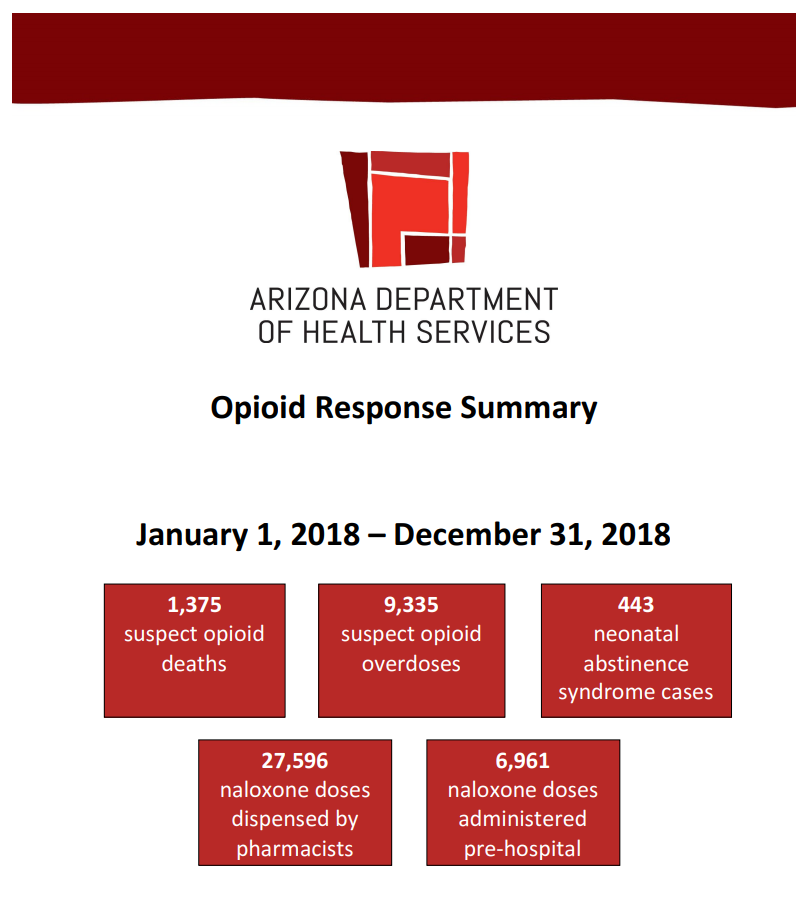 Today we released a new report highlighting recent activities in the fight to reduce opioid overdoses and deaths in our state, and a look at opioid surveillance data in the past year. The report highlights some areas of great progress:
Today we released a new report highlighting recent activities in the fight to reduce opioid overdoses and deaths in our state, and a look at opioid surveillance data in the past year. The report highlights some areas of great progress:
-
ADHS established final rules for pain management clinics and began taking applications in January 2019 to begin regulating these clinics.
-
In conjunction with the Governor’s Office of Youth, Faith, and Family, a social media youth prevention campaign was launched December 31, 2018. The campaign called: “Getting in is easier than getting out” includes online videos, digital ads, and posters for 78 schools statewide. The campaign also includes a website (EasierInThanOut.com) that provides facts for teens about opioids and strategies kids can take to avoid misusing opioids.
-
ADHS worked with 17 undergraduate health professional schools to develop the Arizona Pain and Addiction Curriculum, a statewide curriculum on the modern approach to pain and addiction. Some of its leading themes are destigmatization, the evidence-base of care, and a whole-person perspective. In November 2018, a summit was held to train the faculty of all 17 health professional schools on the new curriculum.
-
Moving upstream from the opioid crisis to launch a public health approach to chronic pain, ADHS launched a new media campaign emphasizing options and self-management strategies for addressing chronic pain. The campaign website increases public awareness and promotes non-pharmacological therapies that are proven to ease pain and increase function.
We also continue to monitor data indicating progress on some of the many interventions and policy measures that went into effect last year. These measures include:
-
The percent of patients receiving referrals by hospitals to behavioral health or substance abuse treatment services after an overdose has increased from 45% in June 2017 to a high of 82% in November 2018.
-
Law enforcement officers have administered naloxone to 685 people through December 2018; 97% survived the immediate pre-hospital event.
-
The total average Morphine Milligram Equivalent (MME) dosage has decreased from an average of 62 in July 2017, to 46.6 in December 2018.
-
The number of opioid naïve patients (people who have not had an opioid prescription in the last 60 days) who had a prescription filled for greater than a 5 day supply decreased 43% between January and December 2018.
-
The number of opioid naïve patients prescribed 90 or more morphine milligram equivalents decreased 51% between January and December 2018.
-
The number of opioid prescriptions filled per month in Arizona declined by 21% in 2018.
Yet, we know the crisis is far from over. The opioid surveillance data indicates an increase in the number of suspected opioid overdoses reported to ADHS, particularly in the last three months of 2018. The data also tell us that:
-
Most overdoses (59%) occur among men.
-
People ages 25-34 years old had the highest percent of opioid overdoses.
-
The most frequently noted pre-existing condition among people who had a verified opioid overdose was history of substance abuse followed by chronic pain (e.g. lower back pain, joint pain, arthritis).
-
About 26% of people who had a suspected overdose during 2018 had 20 or more prescriptions for opioids filled during 2018.
-
Oxycodone, heroin, and benzodiazepines were the most commonly identified drugs involved in verified opioid overdoses.
-
Heroin alone, or in combination with other drugs, was reported to be involved in 25% of verified opioid overdoses.
-
Fentanyl, alone or in combination with other drugs, was reported to be involved in 18% of verified opioid overdoses.
-
Reported overdoses frequently involve multiple drugs.
-
The percentage of health care providers who check the Controlled Substances Prescription Monitoring Program (CSPMP) prior to prescribing a controlled substance has remained largely unchanged in 2018. During the month of December 2018, only 40% of clinicians checked the CSPMP.
The response to the opioid crisis by hundreds of organizations and individuals across Arizona has been enormous. First responders, law enforcement, treatment providers, the medical community, coalitions, community advocates, academic institutions, and public health agencies continue to implement new and existing strategies. We know it will take time to turn the tide on the epidemic.
Many of the provisions of the Opioid Epidemic Act that went into effect in late April were primary prevention strategies to keep people from unnecessary exposure to opioids. New federal resources were provided to Arizona in the fall of 2018 with implementation just beginning on many of the initiatives. So much work is underway, and so much is yet to be done!
The next steps for ADHS will include reconvening partners in April to assess our progress and determine what more can be done to save lives and prevent opioid use disorder from continuing to ravage Arizona’s families and communities.









